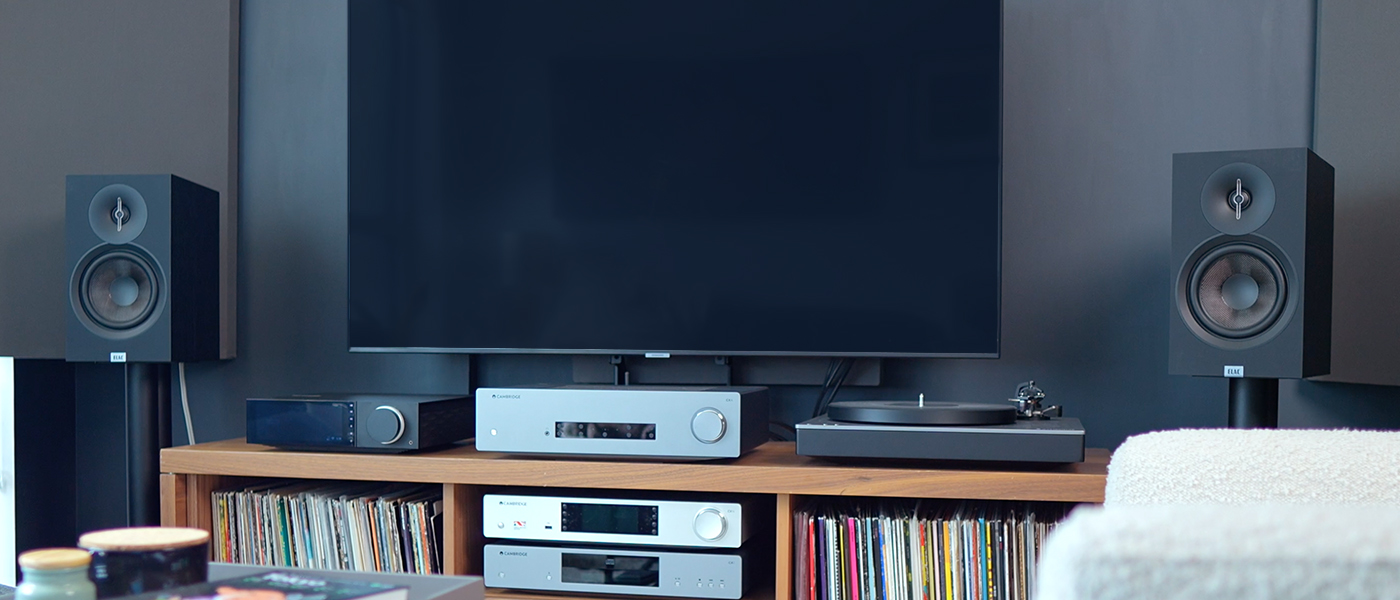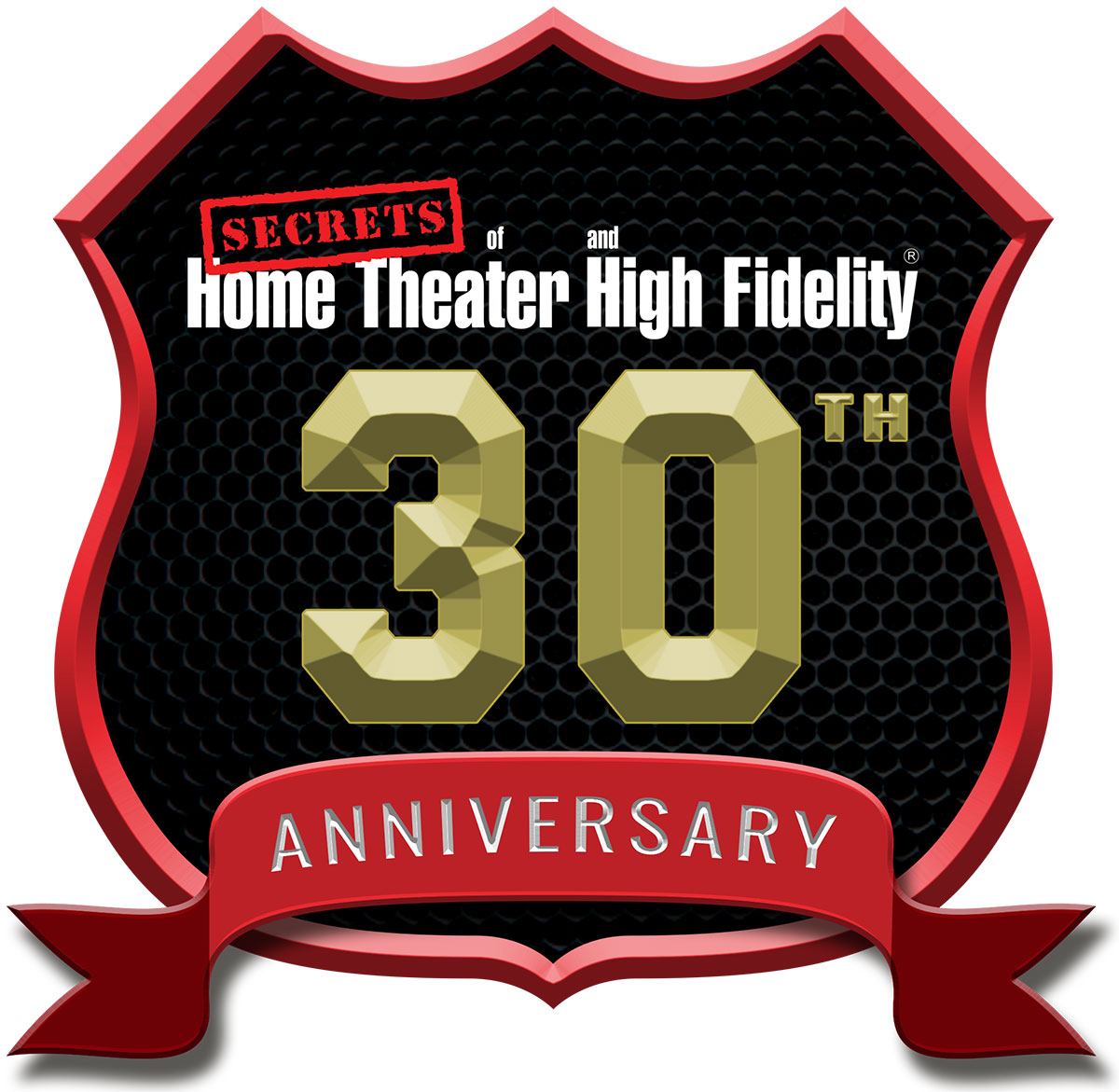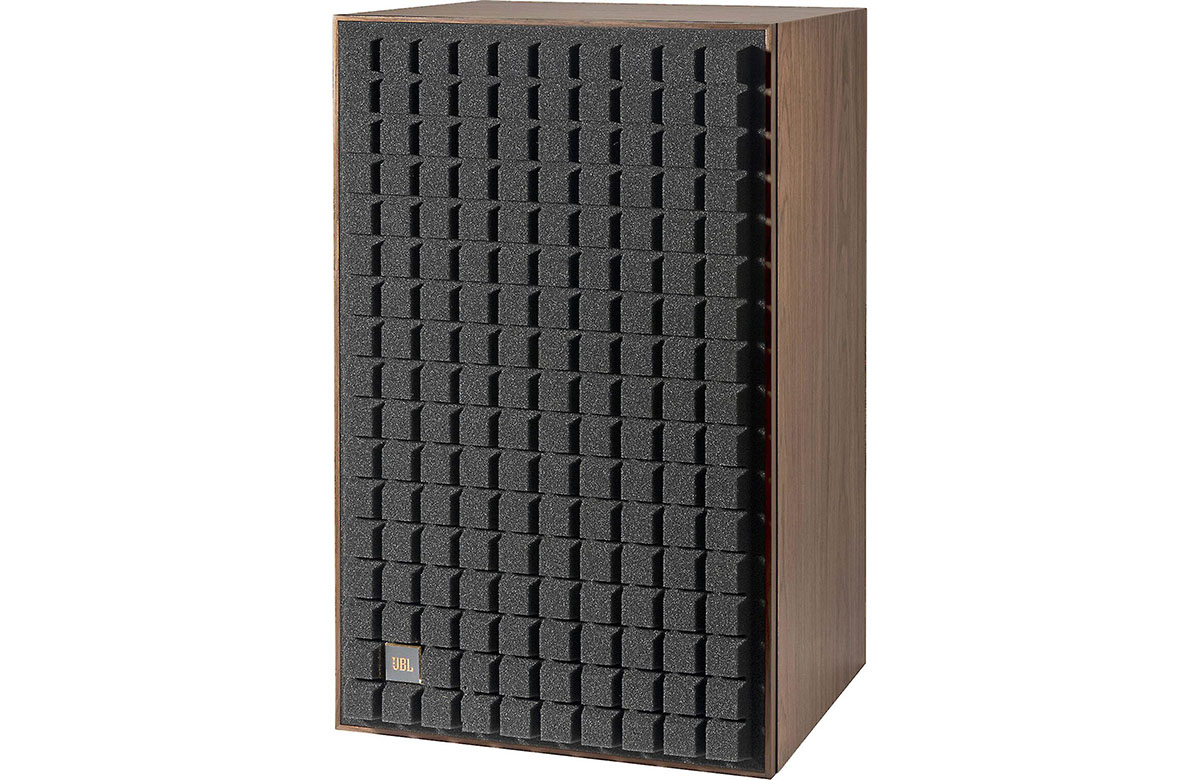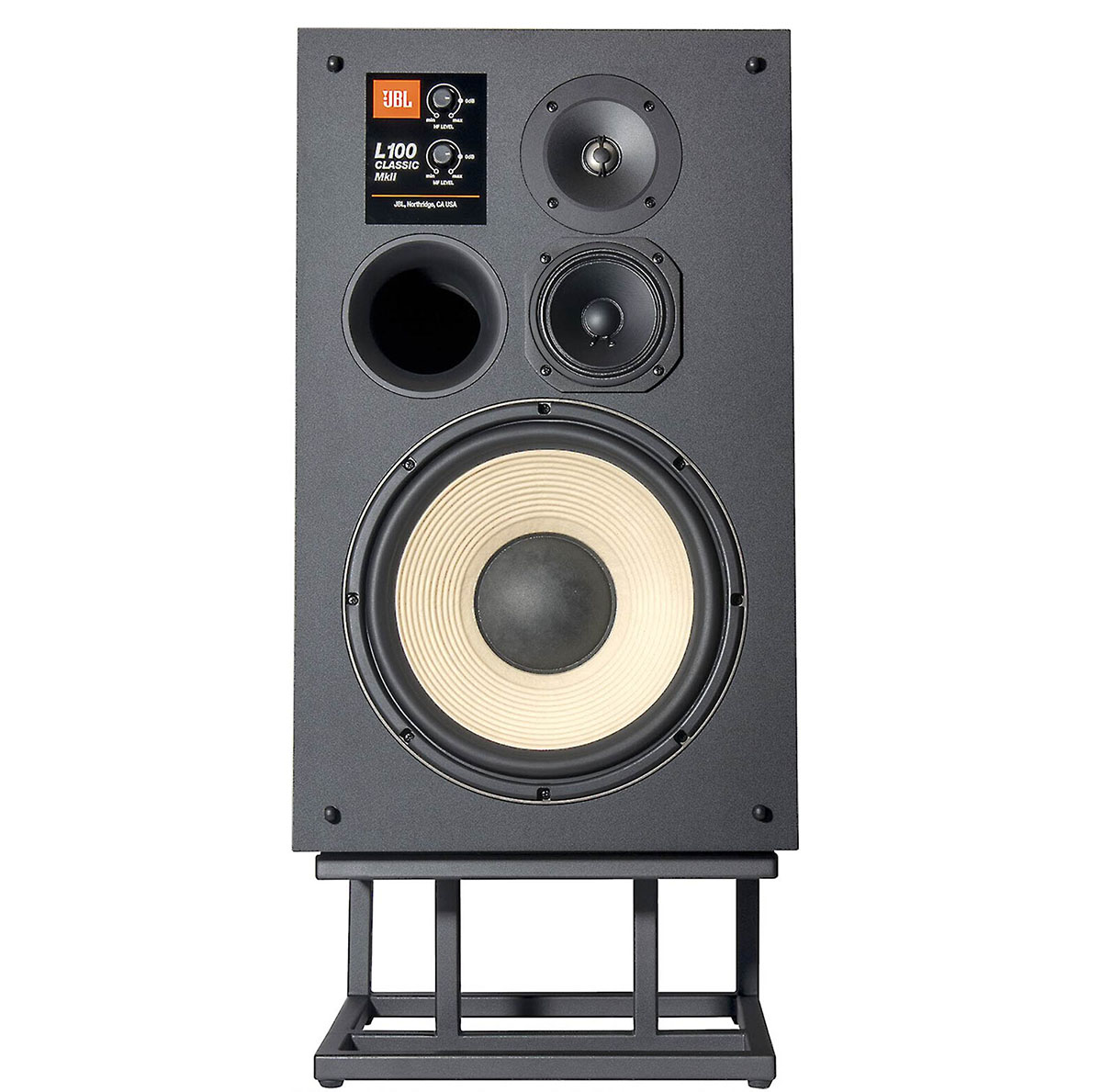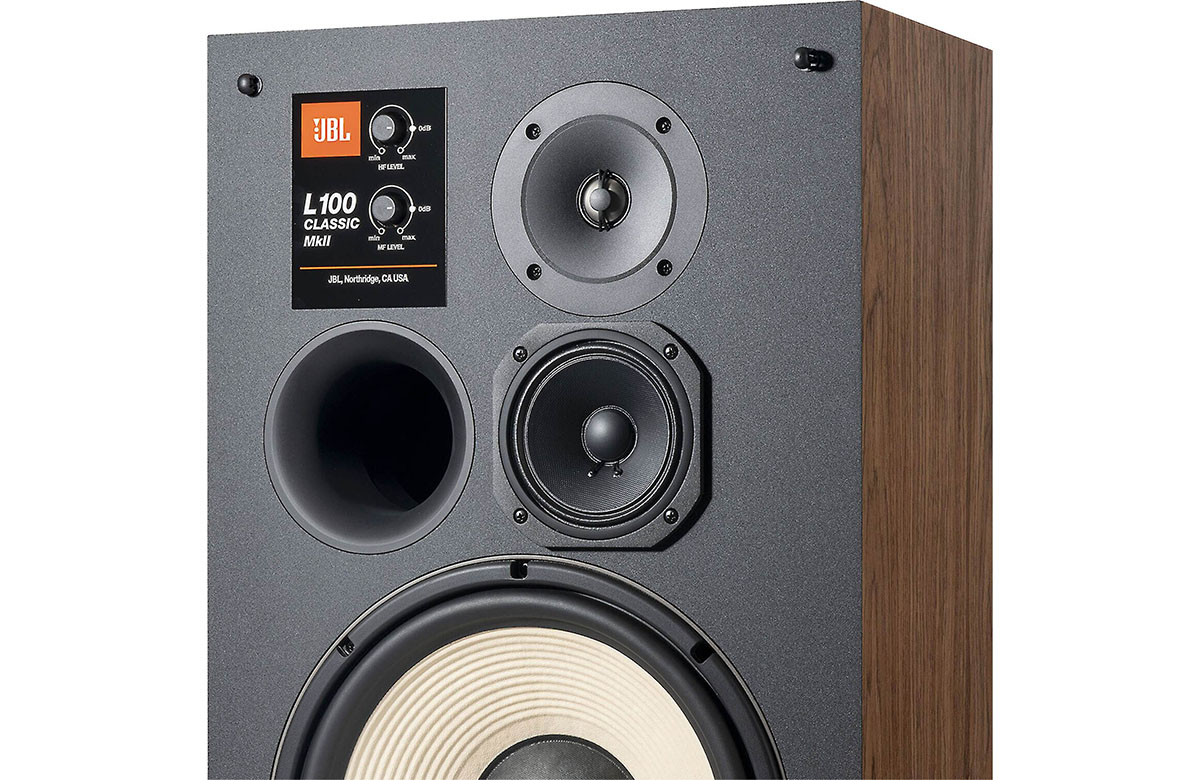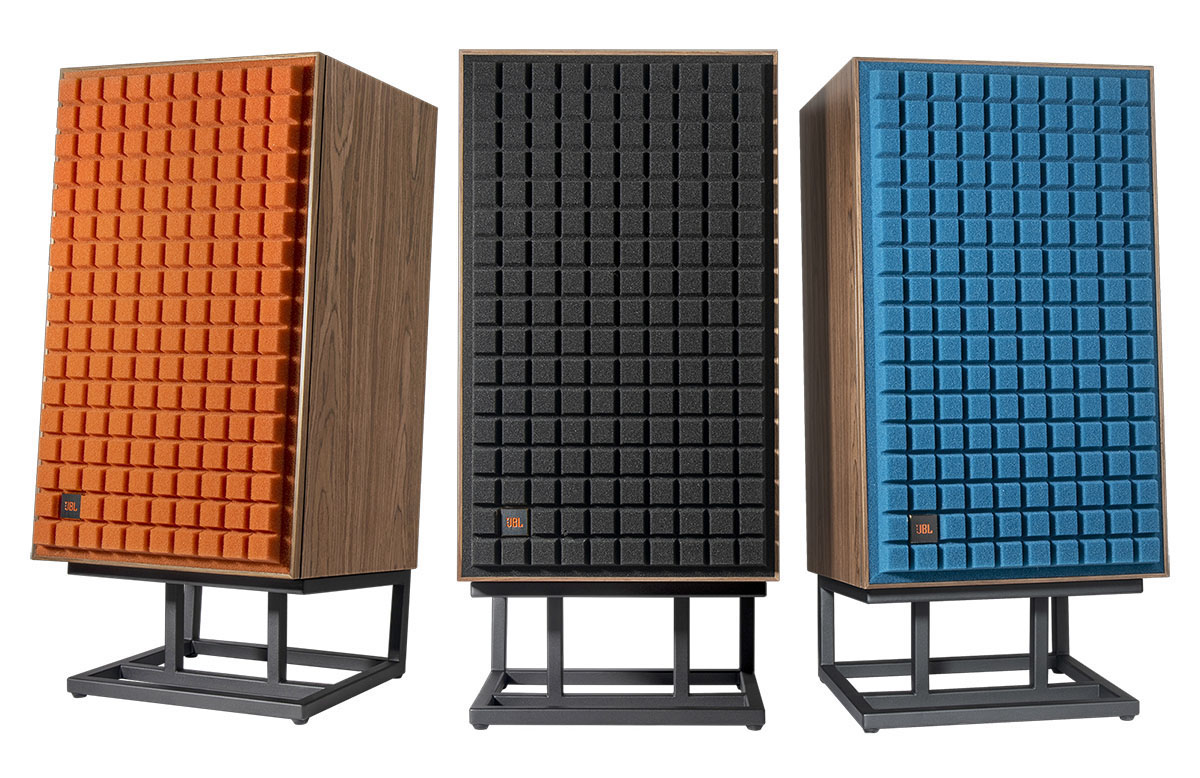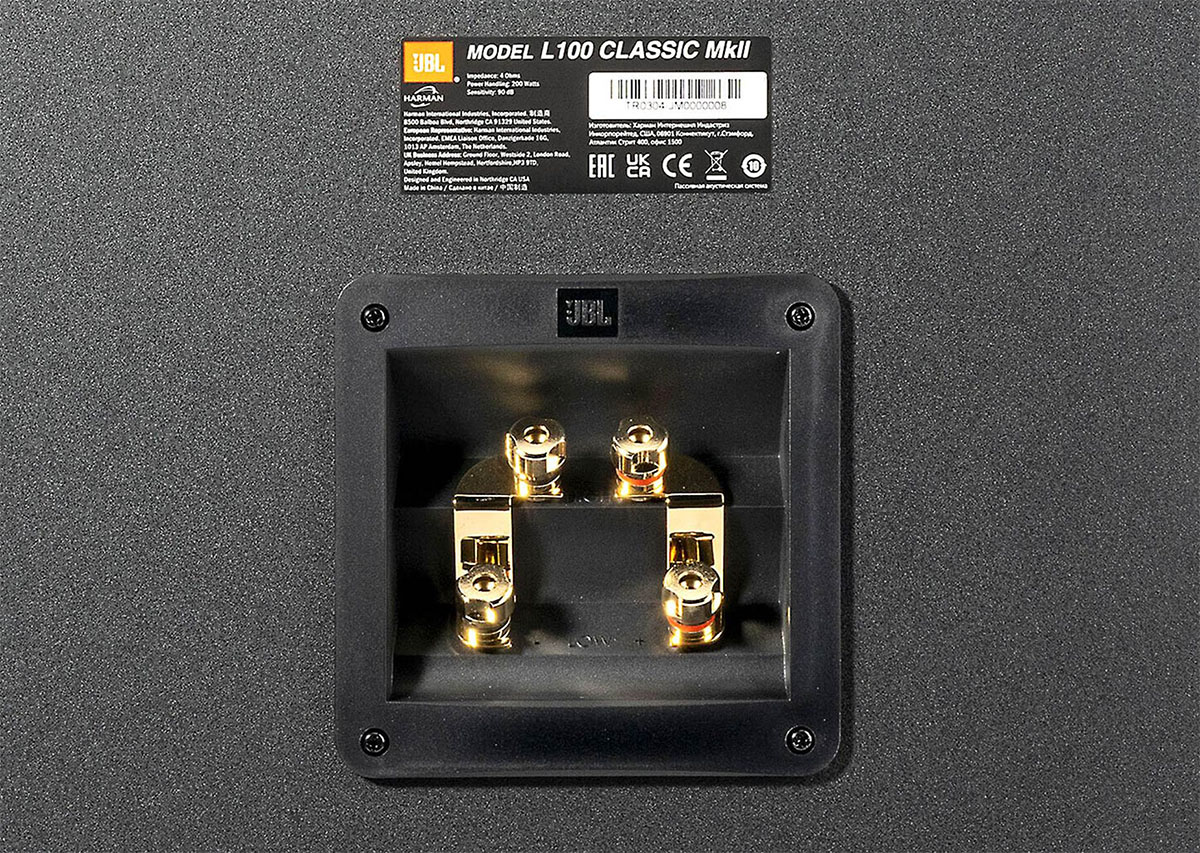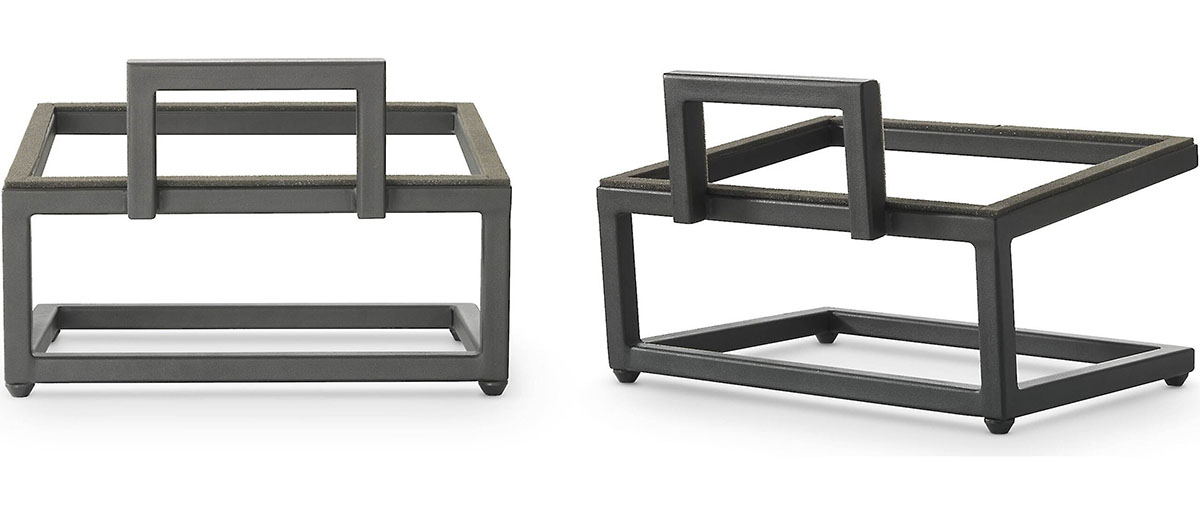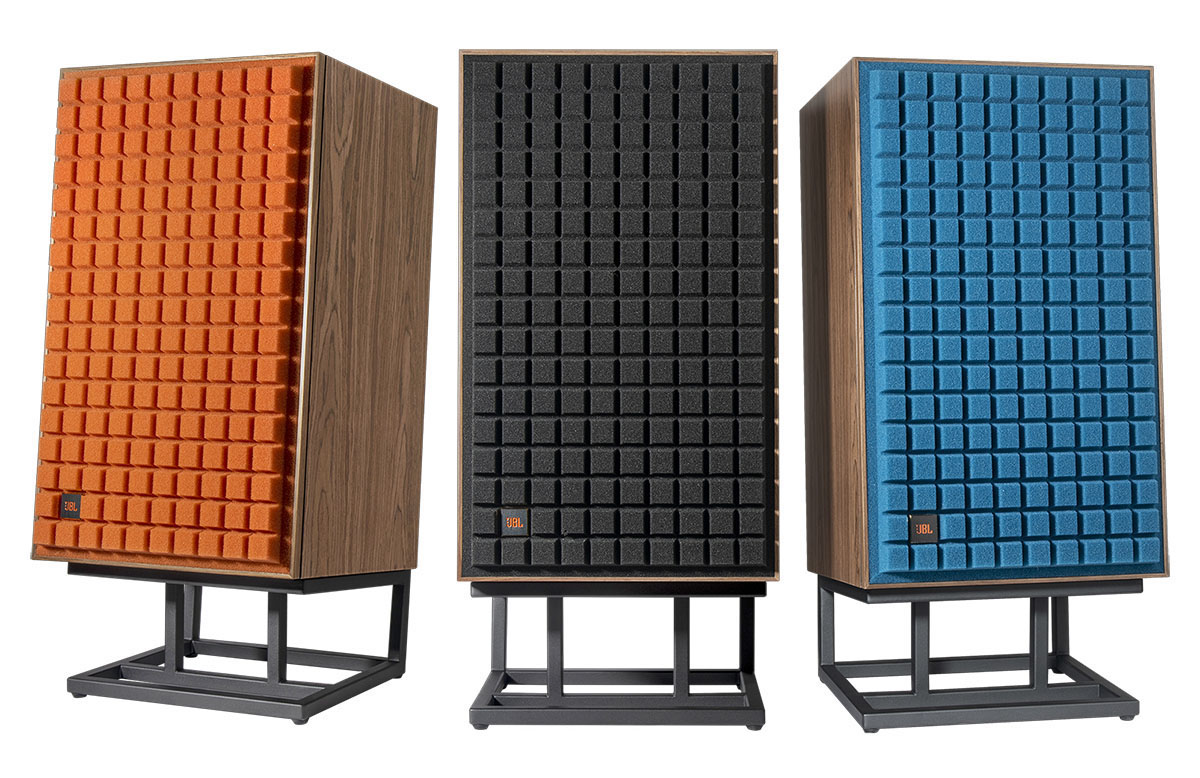JBL’s L100 Classic MkII Speaker is a full-range wide cabinet model with a 12-inch woofer, 5.25-inch midrange and a 1-inch tweeter with an acoustic lens waveguide that plays up to 40 kHz. An updated crossover network includes midrange and high frequency attenuators adjustable by the user. The cabinet is finished in a walnut veneer with a Quadrex foam grill that’s available in three different colors. A large front port extends bass down to 40 Hz.
JBL L100 Classic MkII Speaker
- Ported three-way design with updated crossover.
- Full range playback from 40 Hz to 40 kHz.
- Attenuators for midrange and high frequency adjustment.
- Two pairs of binding posts for bi-wire or bi-amp connection.
- Foam Quadrex grill available in orange, blue or black.
- Finished in walnut veneer.
- Stands available separately.
- Plays loud and clean with a huge sound stage.
My first pair of speakers were Fisher Three-Ways. That has almost nothing to do with this review except for their shape and driver complement. In the days before tall skinny towers, we had wide cabinets that could be compared to the shape of a mini fridge. You’d get a large woofer, 10 or 12 inches, a five- or six-inch midrange and a one-inch tweeter, usually made from doped fabric. A front port extended bass down to maybe 60 Hz. And the grill was permanently affixed.
Now that you have that picture in your head, Google it if you don’t, consider JBL and its history dating back to 1946. It made speakers in that same shape, size and layout. Except they never stopped making them. The L100 Classic has existed in some form for decades. It was reborn a few years ago and today, there’s an upgraded version, the MkII, that brings a new crossover and driver performance enhancements to that same Classic mini fridge cabinet design. You get the same 12-inch woofer, 5.25-inch midrange, one-inch tweeter and large front port as before but the new sound is more precise, and the sound stage is even wider. Let’s take a look.
Speaker Type:
Ported 3-way bookshelf studio monitor
Low Frequency Driver:
12-inch cast-frame pulp cone woofer w/dual spider
Mid Frequency Driver:
5.25-inch polymer-coated pulp cone
High Frequency Driver:
1-inch titanium dome tweeter w/acoustic lens waveguide
Recommended Amplifier Power:
25-200 Watts RMS
Impedance:
4 ohms
Sensitivity (2.83V/1m):
90dB
Frequency Response:
40Hz-40kHz (-6dB)
Crossover Frequencies:
450Hz, 3.5kHz
Controls:
Attenuators for mid and high-level control
Connector:
Dual sets of gold-plated binding posts, jumpers included
Finish:
Natural Walnut veneer with Black, Orange, or Blue Quadrex Foam Grille
Dimensions with grille (H x W x D):
25.3” x 15.4” x 14.4”
Weight:
63 lbs. each
Recommended stand:
JBL JS-120 or JS-150 (sold separately)
Price:
$2,400 each
Company:
SECRETS Tags:
JBL, l100 classic mkii, l100 classic, full range speaker, bookshelf speaker, studio monitor
- SONUS FABER Lumina V Amator Speaker and CI Center Review.
- Dynaudio Emit 10 Bookshelf (Stand-mounted) Speakers Review
- JBL L100 Classic Speakers Review
Secrets Sponsor
I’m going to get this out of the way up front, the L100 Classic MkIIs are in no way, shape or form, bookshelf speakers. It says this on JBL’s website, and it’s printed on the box in big letters. But the only bookshelves they will fit on are at the top of a beanstalk seen only by a giant and a dude named Jack. I’d rather go with a more precise term, Studio Monitor.
The cabinet size and shape have sufficient volume to be a full-range speaker, and the 12-inch woofer certainly advances that design agenda. The cone is made from paper pulp and in its light color, reminds me of the Celestion speakers seen in guitar amps. JBL’s version is much more precise than that and with an accompanying five-inch port, it delivers bass down to 40 Hz (-6dB) with clarity and presence. The cone has a dual spider keeping things together and is firmly bolted down with a metal retaining ring.
The midrange is also pulp but coated with polymer for a bit more rigidity. It’s 5.25 inches across with a butyl rubber surround. The tweeter is a one-inch titanium dome with an acoustic lens waveguide. It is quite deep and almost qualifies as a horn.
In the upper left corner of the front baffle are attenuators for high and midrange adjustment. The dials have subtle and very fine detents but only the 0dB neutral point is marked. There is no indication of how much boost or cut is introduced when turning them, but I made an improvement in my room when I put both knobs at 12 o’clock for a small cut.
The cabinet is made from thick MDF covered in a high-quality walnut veneer. The foam Quadrex grille comes in orange, blue or black and has a wood frame that snaps onto plastic lugs. Today’s fashion tends more toward magnets, and I thought the snap lugs were an odd choice for a $2,400 speaker.
Around back is a large well for the connectors which are very overbuilt. They would look right at home on a McIntosh product. You get two pairs with jumpers included so you can bi-wire or bi-amp if you wish.
To get the L100s tweeters to eye level, you’ll need the special JBL stands which are sold separately. I got a pair of JS-120s that retail for $330. They are very well made, all metal finished in a crackle textured powdercoat. They have plenty of padding to prevent scratches and rubber feet to keep them from sliding or marring your hardwood floors. They hold the speakers at a seven-degree back angle.
The L100 Classic MkIIs are much heavier than they look. My perception is likely affected by memories of those Fishers from my youth that were made from thin plywood and probably no more than 20 pounds apiece. The JBLs have a closer relationship to Earth’s gravity at 63 pounds apiece. I got them up onto the stands and placed them eight feet apart with a toe in angle that crossed about a foot behind my head. This the same angle I use with my reference skinny towers, Axiom LFR1100s.
To drive them, I used two channels of an Emotiva XPA-5 power amp with an Anthem AVM 70 surround processor. I set up two configurations, one with a sub (Axiom EP800), and one without. Music was streamed to the AVM 70’s integrated AirPlay input from an iPhone 12. All the tracks were either lossless, Dolby Atmos or Spatial Audio.
Right off the bat, I noticed that the L100 Classic MkIIs sounded different than what I’m used to. What is that, you ask? I am a fan of the Canadian sound. These are speakers from the Dr. Floyd Toole school of design. You’ll find them sold by Axiom, PSB, Revel, Polk and a few others. The JBLs sound nothing like my Axioms so I had to spend some time retuning my senses. I realized that many speakers today either follow or use elements of the Canadian school, so it’s hard to find something truly different.
The first thing I noted was the sound stage, it’s huge. The L100s have a tremendous width and depth. I say this about a lot of speakers, but these are on another level. They disappear instantly and never call attention to themselves, ever, like, never ever. If you want surround sound from two speakers, I can think of nothing I’ve heard that can do it as well as these. They achieve height as well and create a true concert hall feel and a perfect center image.
After a few hours shakedown time, I was finding upper mid and high frequencies to be a bit harsh. I’m not using any room eq here and the sub is out of the mix. Though there is plenty of low end with clean tight bass, it wasn’t enough to take the edge off. I turned the two attenuators to 12 o’clock which seemed to do the trick. I don’t know how much cut that represents but, in my room, for my ears, it was just right. This adjustability is something that should come with all full range speakers.
I also experimented with sub versus no sub. For all classical and most rock listening, the L100 Classic MkIIs earn the descriptor of full range speaker. Bass is very present, clean and well controlled. But if you plan to play very bass heavy music, we’re talking about lots of content below 40 Hz, you’ll want a sub. And it’ll need to be a big one to properly compliment the JBLs. A small sub won’t provide enough extra juice to make its presence worthwhile. The L100’s 12-inch woofer is very capable, especially when you can drive it with a powerful amp that has the extra headroom.
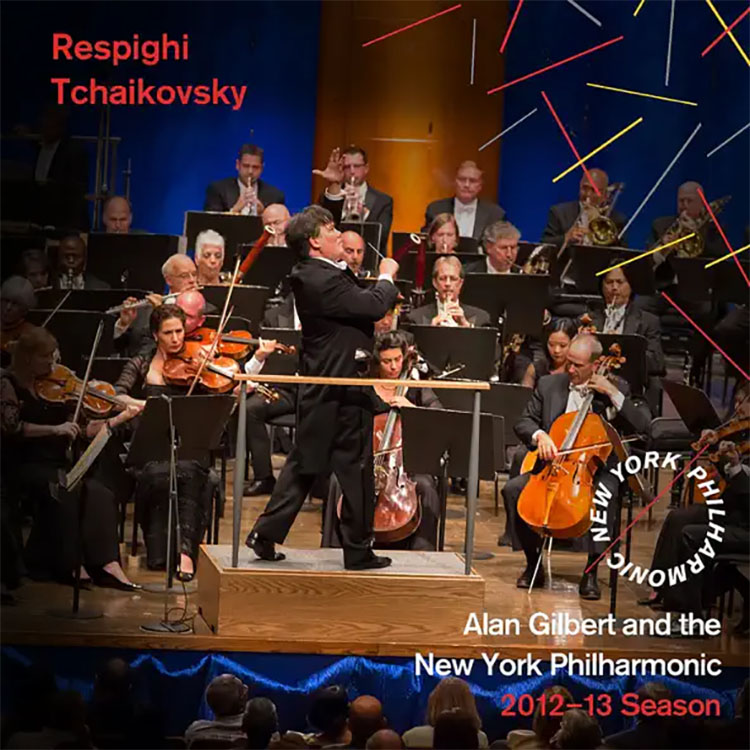
Alan Gilbert and the New York Philharmonic 2012-13 Season, “Respighi, Tchaikovsky”
Moving on to specific examples, I listened to a performance of Respighi’s Pines of Rome from the New York Philharmonic and Alan Gilbert. It was recorded live in the old Avery Fisher Hall which by any account is a space very unworthy of the Phil’s talents. I’ve both performed and attended concerts there and it is dead, as in, like a doornail. The L100 MkIIs did this recording no favors. In fact, I found the speakers a bit too honest. Though they played every nuance with precision, the sound was too narrowly focused. The sound stage was there in the form of ambient cues, a bit of wetness, audience rustling; but the music was lifeless. I’m sure some of this comes from the mix and mic placement as well. Bottom line, the L100 MkIIs won’t make a crappy recording sound good.
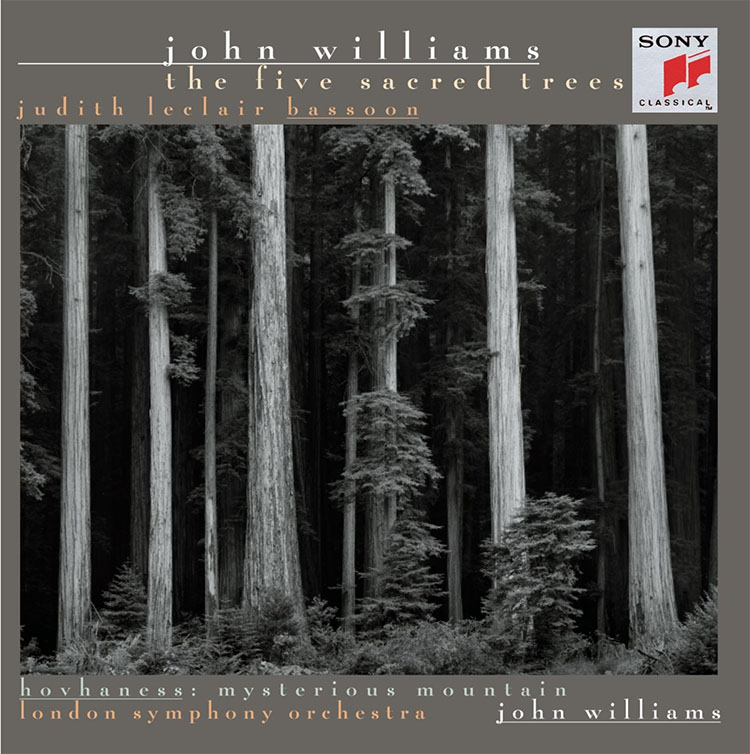
John Williams, “The Five Sacred Trees”
There are few bassoonists, if any, who are as technically precise as Judith LeClair, principal of the New York Philharmonic for over 40 years. She is unfailingly musical, yet every note and interval are performed with a machine-like quality, consistent and perfectly clean. Playing like this is what the L100 MkIIs reproduce best. Her reference recording of John Williams’ Five Sacred Trees with the London Symphony is something I’ve heard hundreds of times on dozens of systems. The JBLs took me to the concert hall and gave me a front row seat. Their dynamics let me hear the most subtle piano and loudest fortissimo with equal precision. At times, the bassoon solo is nearly covered by the large orchestra behind, but you can always hear Ms. LeClair coming through the work’s very layered textures.

Five Finger Death Punch, “War Is the Answer”
While the L100s are very capable with classical music, they are more at home playing rock. In honor of its 15th anniversary, I put on Five Finger Death Punch’s War is the Answer which debuted in 2009. The arena vibe of this thrash metal band was immediately apparent. I noticed expansive bass as well. That’s not a typical term I use when talking about low frequency music, but the 12-inch woofer used here is able to spread that bass energy around the room, as if there were multiple subs. Though it doesn’t have the intensity of a dedicated sub, the L100’s woofer can really deliver. I also enjoyed the balance of vocals and guitars. The layers of the group’s mix were evident with just the right separation so I could hear the individual parts.
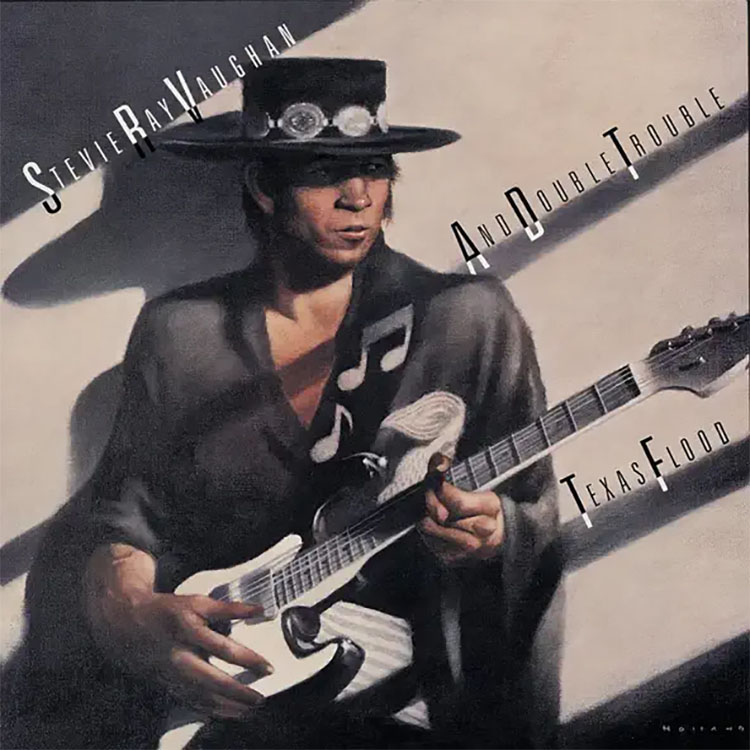
Stevie Ray Vaughan and Double Trouble, “Texas Flood”
I wondered if I could get a club feel from the L100s and was quickly given a positive answer when I played Stevie Ray Vaughn’s Texas Flood. I felt as though I were sitting right under his iconic Stratocaster as he delivered a classic Texas Blues style. His tone, vocal and guitar, were thickly textured and again I could hear the layers.

Coldplay, “Mylo Xyloto”
To enjoy the L100s huge sound stage again, I cued up Coldplay’s album Mylo Xyloto. This is another great example of layered sound. There is so much going on that many systems will just present a loud mush but the JBLs treated each part, each instrument and each voice as a finely rendered line. I could almost copy a musical score by ear if I had been so inclined. Acoustic instruments had the right amount of reverb while synthesized tones occupied their supporting spaces.
Secrets Sponsor
The JBL L100 Classic MkII Speakers are a worthy update. Their vintage style and expansive sound are a welcome alternative to today’s skinny towers.
- Loud clean dynamics.
- Incredibly broad soundstage that extends in all directions.
- Expansive bass.
- Brutally and honestly neutral.
- Frequency attenuators let you dial in just right sound for your space.
- Just a little less brutal honesty and neutrality.
- Include the stands and make the grills magnetic.
The JBL L100 Classic MkIIs were something of an acquired taste for me. As someone used to the Canadian sound and skinny towers filled with lots of drivers, the L100’s vintage engineering and single large woofer delivered a very different experience. And it was one I thoroughly enjoyed. They disappeared instantly into my room and expanded their sound, and my perception, far outside the walls. Club, arena and concert hall were equally well represented, and I could hear layered sounds and individual instruments. They are very capable of full range playback, so a sub is just optional. If you listen to a lot of bass-heavy music or watch movies, then a sub is warranted but make it a big one. The L100’s 12-inch woofer plays clean into the depths and spreads bass around the room like frosting on a cake.
If you’re looking for modern engineering, loud dynamics and clean sound, and you’re into retro style, the JBL L100 Classic MkIIs are as good as it gets.


